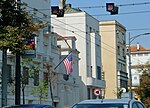Lisičji Potok
Belgrade geography stubsNeighborhoods of BelgradeSavski Venac
Lisičji Potok (Serbian Cyrillic: Лисичји Поток, romanized: Fox Creek) is an urban neighborhood of Belgrade, the capital of Serbia. It is located in Belgrade's municipality of Savski Venac.
Excerpt from the Wikipedia article Lisičji Potok (License: CC BY-SA 3.0, Authors).Lisičji Potok
Славка Ћурувије, Belgrade Београд (Савски венац) (Savski Venac Urban Municipality)
Geographical coordinates (GPS) Address Nearby Places Show on map
Geographical coordinates (GPS)
| Latitude | Longitude |
|---|---|
| N 44.763888888889 ° | E 20.455277777778 ° |
Address
Славка Ћурувије 25
11000 Belgrade, Београд (Савски венац) (Savski Venac Urban Municipality)
Central Serbia, Serbia
Open on Google Maps








